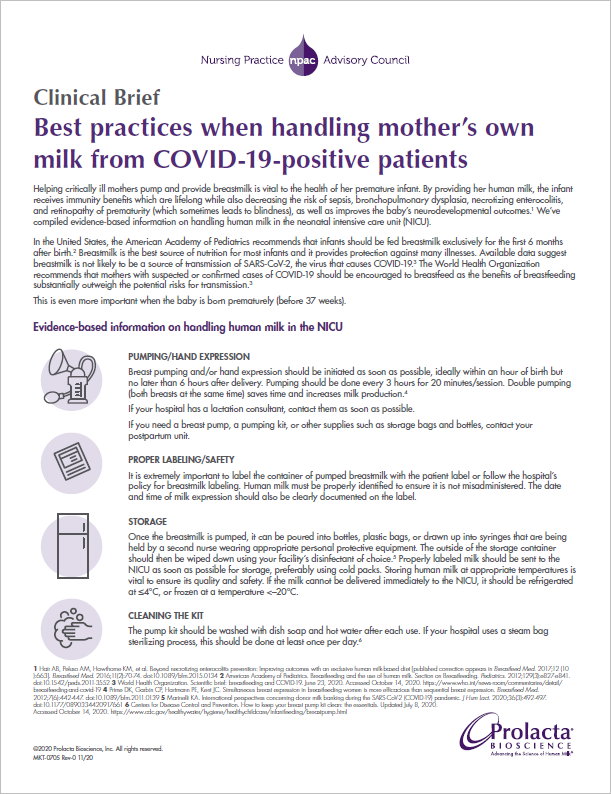Fact Sheet
Best practices when handling mother’s own milk from COVID-19-positive patients clinical brief

Clinical Brief
Best practices when handling mother’s own milk from COVID-19-positive patients
Helping critically ill mothers pump and provide breastmilk is vital to the health of her premature infant. By providing her human milk, the infant receives immunity benefits which are lifelong while also decreasing the risk of sepsis, bronchopulmonary dysplasia, necrotizing enterocolitis, and retinopathy of prematurity (which sometimes leads to blindness), as well as improves the baby’s neurodevelopmental outcomes.1 We’ve compiled evidence-based information on handling human milk in the neonatal intensive care unit (NICU).
In the United States, the American Academy of Pediatrics recommends that infants should be fed breastmilk exclusively for the first 6 months after birth.2 Breastmilk is the best source of nutrition for most infants and it provides protection against many illnesses. Available data suggest breastmilk is not likely to be a source of transmission of SARS-CoV-2, the virus that causes COVID-19.3 The World Health Organization recommends that mothers with suspected or confirmed cases of COVID-19 should be encouraged to breastfeed as the benefits of breastfeeding substantially outweigh the potential risks for transmission.3
This is even more important when the baby is born prematurely (before 37 weeks).
Evidence-based information on handling human milk in the NICU
PUMPING/HAND EXPRESSION
Breast pumping and/or hand expression should be initiated as soon as possible, ideally within an hour of birth but no later than 6 hours after delivery. Pumping should be done every 3 hours for 20 minutes/session. Double pumping (both breasts at the same time) saves time and increases milk production.4
If your hospital has a lactation consultant, contact them as soon as possible.
If you need a breast pump, a pumping kit, or other supplies such as storage bags and bottles, contact your postpartum unit.
PROPER LABELING/SAFETY
It is extremely important to label the container of pumped breastmilk with the patient label or follow the hospital’s policy for breastmilk labeling. Human milk must be properly identified to ensure it is not misadministered. The date and time of milk expression should also be clearly documented on the label.
STORAGE
Once the breastmilk is pumped, it can be poured into bottles, plastic bags, or drawn up into syringes that are being held by a second nurse wearing appropriate personal protective equipment. The outside of the storage container should then be wiped down using your facility’s disinfectant of choice.5 Properly labeled milk should be sent to the NICU as soon as possible for storage, preferably using cold packs. Storing human milk at appropriate temperatures is vital to ensure its quality and safety. If the milk cannot be delivered immediately to the NICU, it should be refrigerated at ≤4°C, or frozen at a temperature <−20°C.
CLEANING THE KIT
The pump kit should be washed with dish soap and hot water after each use. If your hospital uses a steam bag sterilizing process, this should be done at least once per day.6
References:
1 Hair AB, Peluso AM, Hawthorne KM, et al. Beyond necrotizing enterocolitis prevention: Improving outcomes with an exclusive human milk-based diet [published correction appears in Breastfeed Med. 2017;12 (10 ):663]. Breastfeed Med. 2016;11(2):70-74. doi:10.1089/bfm.2015.0134
2 American Academy of Pediatrics. Breastfeeding and the use of human milk. Section on Breastfeeding. Pediatrics. 2012;129(3):e827-e841. doi:10.1542/peds.2011-3552
3 World Health Organization. Scientific brief: breastfeeding and COVID-19. June 23, 2020. Accessed October 14, 2020. https://www.who.int/news-room/commentaries/detail/breastfeeding-and-covid-19
4 Prime DK, Garbin CP, Hartmann PE, Kent JC. Simultaneous breast expression in breastfeeding women is more efficacious than sequential breast expression. Breastfeed Med. 2012;7(6):442-447. doi:10.1089/bfm.2011.0139
5 Marinelli KA. International perspectives concerning donor milk banking during the SARS-CoV-2 (COVID-19) pandemic. J Hum Lact. 2020;36(3):492-497. doi:10.1177/0890334420917661
6 Centers for Disease Control and Prevention. How to keep your breast pump kit clean: the essentials. Updated July 8, 2020. Accessed October 14, 2020. https://www.cdc.gov/healthywater/hygiene/healthychildcare/infantfeeding/breastpump.html
